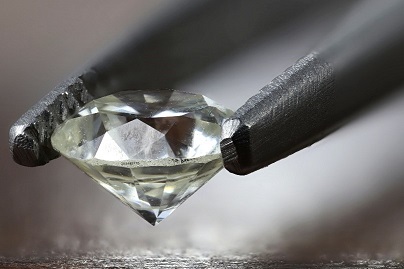Gemstone as Investments?

Gemstone as Investments?
For the past several days, Marc Anthony has been given the highest level of stately treatment as he sits in the court of Cleopatra, the last queen of Egypt. Despite the grandeur of the banquets, Cleopatra has shown nothing but disdain. She is quick to disregard the roasting of the eight wild boars prepared for the twelve attendees and the jewel encrusted golden goblets and platters that her guests will be allowed to keep as trivial tokens. This evening is the night to prove her wealth to Rome. She has challenged Marc Anthony by stating everything up to this point has been nothing but cheap imitations of what she could serve to honored guests. As Marc Anthony expresses disbelief, she declares she will provide an exorbitant banquet at the cost of 60 million sestertii. In today’s terms that amount of Roman coinage would equate to $28.5 million U.S. dollars. The challenge is accepted: when a goblet is placed before Cleopatra, she removes a large exquisite pearl from her earring and tosses it into her drink. The acidity of the concoction dissolves the pearl and neutralizes its contents at the same time. With that she drinks her pearly concoction, thereby winning the challenge.
Pearls were once known as the queen of all gems. They were a natural rarity and perceived as far more precious than gemstones. You may have even heard the famous story of how New York’s Cartier building was exchanged for two strands of pearls. Today a strand of pearls is of little worth in comparison to how they were valued in the past. Why is it that pearls contained such value and what was it that nearly tore their value to the ground?
Traditionally pearls could only be acquired by divers and depending on the species, a pearl could only be found in as many as one out of every five hundred thousand mollusks. Then Kokichi Mikimoto developed an effective way to culture pearls in his native homeland of Japan and soon opened stores around the world. The rarity of the pearl diminished. What was once reserved exclusively for royalty was now readily available to the public. Is it possible such a disruption could happen yet again? In a way it has, but via synthetic and lab created gems. Where does technology stand today in its ability to create authentic gemstones? Lab grown and synthetic gems are messy terms, and this is in part due to the varying methods used in their creation. Below are ways to identify how natural gemstones are formed in comparison to methods used today to create gems.
Natural Gemstone Formation
There are several ways gemstones can form naturally. To state it in simplest terms, they grow deep in the ground after various constituent elements are exposed to intense pressure and heat for a prolonged period. The type of gem created depends entirely on what elements are combined and the amount of pressure and temperature present during the growing process. Eventually, as the earth’s plates shift due to seismic activity, the gems are pushed closer to the surface where they are discovered and mined.
The Flame Fusion Method
The flame fusion method is the simplest way to create gemstones. It occurs by melting the various constituents that make up the gem and layering them on top of one another. It takes about an hour and costs about a penny per carat to make. If the constituents to form sapphires are melted and combined, it can legally be called “created sapphire”. Geologically this sapphire is nothing like ones that form in nature as it lacks the crystal structure of authentic gems. It is the crystal structure that gives the stone it’s brilliance when cut.
The Flux Grown Method
Gemstones created using the flux method are grown in a chamber which seeks to duplicate the exact heat and pressure conditions that exist deep in the earth where gems form in nature. The process can take over a year to complete depending on what type of gem is being grown. The structure, which gives the stone its brilliance, is identical to that of mined gemstones. Overall, the end-product is superior to gemstones formed in nature as many of the characteristic flaws associated with the region are absent. The cost of a flux grown stone is still expensive, but significantly less than that of mined gemstones and only a highly skilled gemologist is able to differentiate between them.
Why Gems Prices Haven’t Fallen Like Pearls
Given the fact that flux grown gemstones are superior in quality to naturally mined gems, why haven’t prices of mined gems dropped like the pearls did? The reason lies in legalities and buyer education. When the chemist Carroll Chatham first put his flux grown emeralds on the market, he was met with a slew of lawsuits from the gem industry. They had observed the value of pearls decline and were horrified that the same thing would happen to them. While Chatham didn’t lose the lawsuits, a settlement was reached that would allow him to continue his life’s work and get back to business. What were the details of the settlement? He could not use the term “cultured” to describe his gemstones. The result of this label differentiation allowed the gemstone industry to wrongfully discredit the value of flux grown gemstones. The bias in the industry to label flux grown gemstones as inferior has also helped maintain high prices for mined gems. Commonly flux grown gemstones are perceived as imitations of the real thing, take cubic zirconium for example. While this certainly is not a precious gem, the fact that it is used as a diamond look a-like in jewelry, blasts the dark label of a cheap synthetic on all lab grown gems.
Which to Purchase?
For those looking to purchase gems for non-investment purposes, consider flux grown from a reputable source such as Chatham Created Gems and Diamonds. Tom Chatham has been an interview guest on GROCO’s American Dreams program. Tom’s father is the man who pioneered flux grown gems and these gemstones are superior to most of those naturally mined, and at a third of the price.
When purchasing for investment reasons in the current market, only consider acquiring minded gemstones. While they are essentially the same product as those that are flux grown, due to public perception flux grown do not have the same market value. And as ever, it is advisable to consult a reputable dealer such as, Stephen Silver, an expert located in the San Francisco Bay Area. He has significant experience with gem investments, and was the person who sold The Pink Promise Diamond at Christies Auction for $32 million in 2017.
Just be aware, if you are considering investing in gemstones, buy them as close to the actual source as possible. Once gems hit the retail market, they can be marked up as high as 10 times their actual value, which means that you probably won’t recover your investment- even in the long run. One last note of caution when investing in gems, keep in mind what has happened to the pearl market because history can still repeat itself.
If you have any questions or would like more information about objective investment, tax or family office, advice (we never sell investments), please consider contacting us here at Info@GROCO.com. Or, visit our website at www.GROCO.com to learn more about us. Unfortunately, we no longer give advice to other tax professionals gratis.
Follow GROCO on Facebook
Contact us here
It Pays to Be Rich for These Five Tax Breaks
It Pays to Be Rich for These Five Tax Breaks Although it’s true that the ultra-wealthy are heavily taxed, and in many cases unfairly, there are also some tax break advantages that favor the upper class more than those in the middle. Let’s take a look at some of these breaks. Most common and first…
New Jersey Governor Says Enough is Enough on Taxing the Wealthy
New Jersey Governor Says Enough is Enough on Taxing the Wealthy It seems that no tax is a bad tax when it comes to the “left” side of the government. It’s a well-known fact that the wealthiest Americans pay the largest portion of the country’s taxes. However, there are some government leaders that lean “right”…
Clinton’s Using Careful Strategies to Avoid Tax They Support
Clinton’s Using Careful Strategies to Avoid Tax They Support Have you ever wondered what wealthy democrats do when tax laws they support and vote for come back to apply to them? Although people typically associate being wealthy with republicans, there are plenty of rich democrats in the nations’ capitol as well. So just what do…
California Going After Tax-Evaders
We have discussed the federal government’s efforts to track down tax-evaders many times before, but the IRS isn’t the only tax agency looking to crack down on those who don’t pay their fair share of taxes. The California Franchise Tax Board is in the middle of a five-and-a-half-year effort to automatically find and identify noncompliant…



